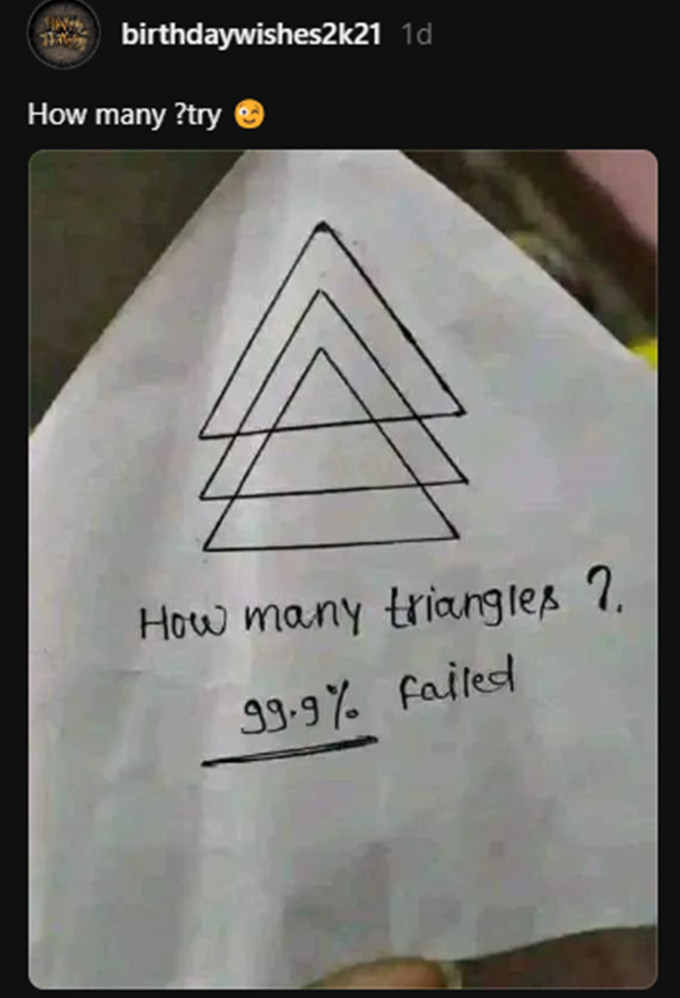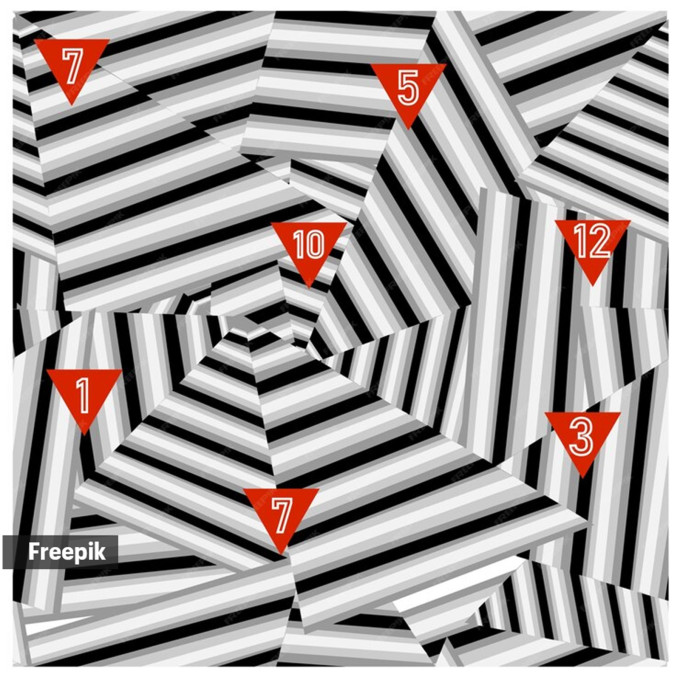99.9 % people ‘failed’ to count the number of triangles in this puzzle; data scientist shares ways to solve shape-based riddles
Shape-based puzzles often leave people scratching their heads. These puzzles can be deceptively difficult, as they challenge our brain’s ability to interpret visual information and resist common cognitive traps.
Try one yourself:

 Source: Threads/Happy Birthday Wishes Pictures
Source: Threads/Happy Birthday Wishes Pictures
The challenge of such puzzles lies in the brain’s intricate processing of visual stimuli and the cognitive mechanisms involved in solving them. Gurleen Baruah, organisational psychologist and executive coach at That Culture Thing, says, “Puzzles involving shapes and optical illusions, like counting triangles, often seem more challenging because they tap into the complex way our eyes and brain work together to interpret visual information.”
When we look at an image, she continues, our eyes send signals to the brain, which then tries to make sense of what we’re seeing. However, our brain doesn’t just passively receive this information; it actively interprets it, sometimes making quick assumptions based on patterns, depth, and past experiences.
Mathematical principles that are often used to create optical illusions in puzzles
Shreya Singh, data scientist based in Bengaluru, tells indianexpress.com, “Optical illusions in puzzles often exploit our brain’s reliance on certain mathematical principles to create visual confusion.” Some common techniques include:
Forced Perspective: Playing with relative sizes and distances to create misleading depth perception. Our brains instinctively interpret objects that are larger as being closer, and those smaller as farther away. Illusions can manipulate this by presenting objects in unexpected sizes, tricking us into perceiving impossible spatial relationships.
Ambiguous Figures: Crafting images that can be interpreted in multiple ways. This ambiguity arises from our brain’s tendency to quickly seek out recognisable patterns. When a figure presents multiple possible patterns, our perception can flip between them, leading to the illusion of change or movement.
Impossible Objects: Depicting shapes or structures that defy the laws of geometry. These illusions exploit our brain’s built-in assumptions about how objects should exist in three-dimensional space. By presenting conflicting visual cues, they create a sense of paradox and impossibility.
Gestalt Principles: Utilising our brain’s natural tendency to group visual elements based on proximity, similarity, continuity, and closure. These principles can be cleverly manipulated in puzzles to either camouflage shapes or create false patterns, making it challenging to discern individual elements.
Common cognitive biases or errors do people tend to make when solving shape-based puzzles
Baruah explains, “One major bias is our brain’s tendency to see patterns, even when they aren’t there. This trait, known as pattern recognition, helped our ancestors survive by quickly identifying potential threats or resources in their environment.”
Another common bias is confirmation bias, she states, where we tend to focus on information that supports our initial interpretation while ignoring conflicting evidence. This can happen in puzzles when we latch onto the first pattern or shape.
“Our brains also rely on Gestalt principles to make sense of complex visual information. These principles help us organise shapes and patterns into a coherent whole, which was useful for navigating our environment. However, in puzzles, these principles can lead us to see connections or complete shapes that aren’t really there,” confirms Baruah.
We also tend to fall into the trap of anchoring bias, where we fixate on the first piece of information we identify and base all our subsequent decisions around it.
 Identify the most obvious and largest shapes first. (Source: Freepik)
Identify the most obvious and largest shapes first. (Source: Freepik)
Strategies or techniques can be used to systematically count shapes in puzzles to avoid common mistakes
When faced with a complex puzzle, Singh suggests employing a systematic approach can greatly improve your accuracy and prevent frustration:
Break it Down: Divide the puzzle into smaller, more manageable sections. This allows you to focus on one area at a time and reduces the chance of overlooking smaller shapes.
Start Simple: Identify the most obvious and largest shapes first. This provides a foundation for spotting smaller shapes that might be formed within or around them.
Look for Overlaps: Pay close attention to areas where shapes intersect. Overlapping regions often create new, smaller shapes that are easy to miss.
Trace and Label: Use a pencil or your finger to trace the outlines of each shape as you count them. This helps you keep track and avoid double-counting. You can also label each shape with a number or letter for further clarity.
Change Perspectives: If you’re stuck, try rotating the puzzle or looking at it from a different angle. A fresh perspective can sometimes reveal hidden shapes or patterns.
Take Breaks: If you start to feel overwhelmed, step away from the puzzle for a few minutes. Returning with fresh eyes can often lead to new insights.
📣 For more lifestyle news, click here to join our WhatsApp Channel and also follow us on Instagram
Disclaimer: The copyright of this article belongs to the original author. Reposting this article is solely for the purpose of information dissemination and does not constitute any investment advice. If there is any infringement, please contact us immediately. We will make corrections or deletions as necessary. Thank you.

